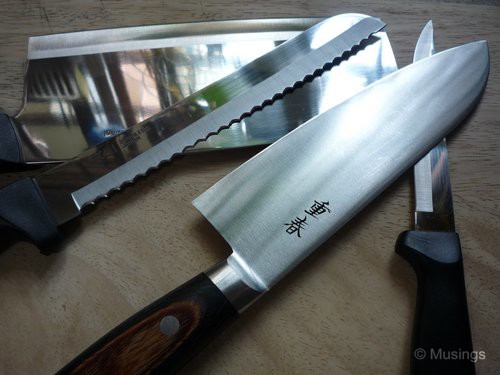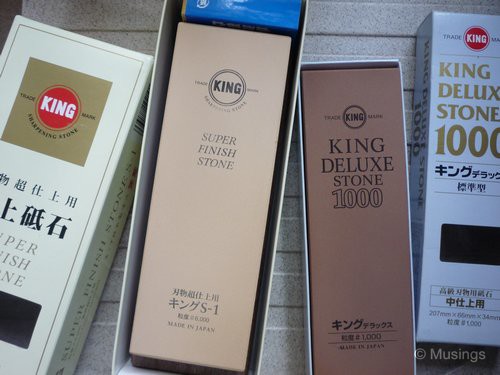1) Do you maintain your kitchen knives regularly at screaming sharp edges?
2) Do you clean and dry your knives soon after use?
3) Do you know that full tang is not necessary for a good knife?
4) Do you know that wooden chopping boards can trap as much germs as plastic ones?
If your answers to the above questions tend towards ‘Mmm-huh?’, then you have company, and plenty of it. :)
After acquiring a kitchen knife from a well-known knife maker in Kyoto during our Japan trip last year, it got me rather hooked onto understanding more about kitchen knives. I started reading this highly recommended knife book ‘An Edge in the Kitchen’ by Chad Ward to learn more about types of knives, their uses and how to maintain them. The writer, who is a chef himself, has an impressive and up-to-date knowledge of this essential kitchen tool, knows how to wield it and maintain it at peak performance.
From what I’ve gathered, unless you’re a chef of some sort you basically need about two to three types of knives for typical home use.

1) Chef’s Knife: This is THE knife you use most of the time for cutting, slicing, dicing, chopping, you name it. In fact, if you have budget for just one knife, this is it. Don’t be fooled into buying a knife set with other knives thrown in thinking that you are getting a good bargain. Truth is, other knives in the set would be sitting in the knife block unused while the chef’s knife calls the shots day in and day out. Therefore, choose a good chef’s knife that is either hand-made (forged) or machined (not the cheap stamped ones). Okay to get some idea, those stamped knives sold at NTUC are the ones to avoid if you want good knives that last. To maintain the chef’s knife, you would need at least 2 good whetstones (water stones) of different grit to sharpen it occasionally.
2) Paring Knife: This is something like a smaller chef’s knife. It is smaller for easy peeling of fruits, deveining prawns, intricate carvings and the like. We use this knife 20% of the time.
3) Bread knife: This is a long knife with serrated or scalloped edge for cutting well, bread of course. If you often eat bread (I also use it to cut the cakes I bake), this would come in handy. However, unlike the chef’s knife, don’t spend too much on the bread knife as its edge is too tedious to sharpen and hence it won’t last as long as you like. Just buy a new one when the current one loses its desired sharpness.
4) Cleaver: If you cook Asian dishes like we do sometimes, you would probably find a cleaver handy on top of the 3 knives mentioned above. We use the cleaver for hacking spare ribs, coconuts and cutting through hard vegetables such as corn, winter melon, pumpkin, etc. We also use it to slice fish fillet just in case we hit a hard bone or scales and chip the sharp edge of our precious chef’s knife.
There are just about 2 types of steel to choose in a knife. Either carbon steel or stainless steel. The former alloy will allow the knife to take on a very keen edge but the downside is maintenance. Carbon steel rust readily if not cleaned and wiped dry immediately after use. The stainless steel knife will not rust as easily but pales somewhat in terms of screaming sharpness. Then again, there are those sophisticated grades of stainless steel thanks to advanced technology today that boast improved performance over their inferior cousins.
In Singapore, it is not easy to find suitable whetstones from departmental stores. Most, however, sell knife sharpening devices which might be set at inappropriate angles to sharpen your knives to make them last. I bought one whetstone of 1000 grit together with the chef’s knife while in Japan and Yang helped me acquire another whetstone of 6000 grit from an online store. The 1000 grit is meant for sharpening while the 6000 grit does fine polishing to make the edge last longer. I must add that sharpening knives is not as daunting as it looks or sounds. It takes some practice of course.

Finally, Ward kept reminding his readers the usefulness of having a finely grooved honing rod as well. It helps to straighten any rolled over edge on the knife to keep it at peak performance longer. This is probably the final item we would acquire to complete our knife maintenance at home.
Very informative. I wish I had come across this before buying another chef’s knife!
Matt, care to describe your new chef’s knife? :) What’s wrong with your previous one?
That’s just the thing: I know nothing about my new chef’s knife! A young lady in my office sold it to me from a catalog, but it’s yet to arrive. I’m sure it’s nothing special. I only purchased it to help her sales numbers. : )
Nice guy :)